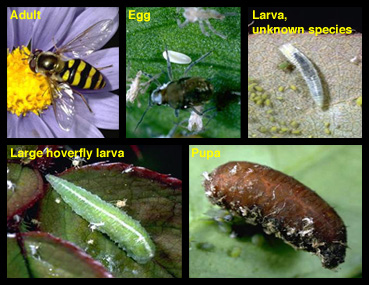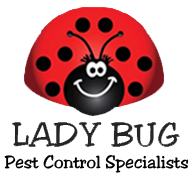Another beneficial predator of aphids other than LADY BUGs and LACE WINGS, is the larva of flies called Syrphid flies, in the family Syrphidae.

These flies also may be called hover flies or bee flies, because many of them strongly resemble bees or wasps, and they may be seen hovering in mid-air, using their extremely fast wing beat to keep them in one place while they examine their surroundings. This strong resemblance to stinging insects is thought to provide these harmless flies with some measure of protection from their own predators, which may perceive them as an insect that might sting in response to an attack. In reality, Syrphid flies cannot bite or sting, and should be preserved when found. Some species are remarkably similar to bald-faced hornets or yellow jackets, but you can distinguish them from bees or wasps by the fact that flies have only 2 wings, and not the 4 wings of wasps.
The adult flies feed only on nectar, but the larvae are the predators, and are capable of consuming large numbers of aphids. Unfortunately, the larvae resemble small caterpillars – larvae of moths – and again the homeowner is unlikely to know what he is seeing and ask that they be killed. The distinction here is that the fly larvae have 3 pairs of short legs at the front of the body, but do not have any of the little suction-cup-like “prolegs” along the middle of the body. These are voracious feeders, and typically the population of predators will follow shortly after the parasites appear on the plants. If you begin to notice the early spring leaves starting to curl and twist on fruit trees, it can be the result of the feeding of a lot of aphids. Usually there can be thousands of aphid predators on the scene, taking care of the problem – syrphid fly larvae and lady bug larvae in particular. To spray the tree now with an insecticide would do very little good for the tree, but would kill all of these valuable predators, so I leave it alone and enjoy the show. Within a few more days all of the aphids will be gone anyhow, and any leaves badly distorted will fall off and be replaced by new leaves. Avoid applying an insecticide, which should be the goal whenever possible.
There are predators of aphids, and parasites of aphids. The difference between “predators” and “parasites” is subtle, and generally refers to whether the prey is consumed quickly or slowly. The insect larvae we have discussed so far are all predators. They capture an aphid and consume it quickly and completely. Parasites, such as the tiny wasp larvae in the family Braconidae, live inside the aphid, consuming it more slowly and cryptically. This still results in the death of the aphid, but it may take a few days or more to complete the process. This wasp family is one of the most important groups in the Hymenoptera – the Order of wasps, bees, and ants – and the larvae of the many thousands of species of Braconids feed on virtually any kind of insect larva, including caterpillars, beetles, flies, true bugs, aphids and scales, and even other wasps. Logically, those that feed on tiny aphids are tiny wasps themselves.
If you have concerns and want a Free Home Inspection contact Lady Bug Pest Control Specialists for a Free Home Inspection for Termites, Eco-Friendly Pest Control, Home Seal Service, Bed Bug Eco-Heat, and Rodent Control. We perform Complete Home Inspections at no charge. Please feel free to contact Lady Bug Pest Control Specialists to answer any questions or for a FREE Inspection. 480-833-1111.
Lady Bug Locations: Lady Bug Eco-Friendly Pest Control provides service Valley Wide including Mesa, Tempe, Scottsdale, Paradise Valley, Phoenix, Cave Creek, Care Free, Fountain Hills, Gilbert, Chandler, Queen Creek, San Tan, Sun City, Peoria, Buckeye, Avondale, Good Year, Glendale, Surprise, Apache Junction, Gold Canyon, Anthem, Ahwatukee, and El Mirage.







